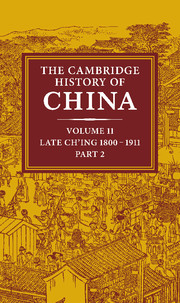Book contents
- Frontmatter
- 1 Economic trends in the late Ch'ing empire, 1870–1911
- 2 Late Ch'ing foreign relations, 1866–1905
- 3 Changing Chinese views of Western relations, 1840–95
- 4 The military challenge: the north-west and the coast
- 5 Intellectual change and the reform movement, 1890–8
- 6 Japan and the chinese revolution of 1911
- 7 Political and institutional reform 1901–11
- 8 Government, merchants and industry to 1911
- 9 The republican revolutionary movement
- 10 Currents of social change
- Bibliographical essays
- Bibliography
- Index
- Map 1. Ch’ing empire – physical features
- References
1 - Economic trends in the late Ch'ing empire, 1870–1911
Published online by Cambridge University Press: 28 March 2008
- Frontmatter
- 1 Economic trends in the late Ch'ing empire, 1870–1911
- 2 Late Ch'ing foreign relations, 1866–1905
- 3 Changing Chinese views of Western relations, 1840–95
- 4 The military challenge: the north-west and the coast
- 5 Intellectual change and the reform movement, 1890–8
- 6 Japan and the chinese revolution of 1911
- 7 Political and institutional reform 1901–11
- 8 Government, merchants and industry to 1911
- 9 The republican revolutionary movement
- 10 Currents of social change
- Bibliographical essays
- Bibliography
- Index
- Map 1. Ch’ing empire – physical features
- References
Summary
There was little of the Chinese economy prior to the twentieth century that was not included within the agricultural sector or quite intimately connected with it. The bulk of the following essay ought properly to be devoted to an analysis of the structure and development of Chinese agriculture in the nineteenth century and its implications for the rest of the economy. I have, however, while discussing agriculture first, given roughly equal attention to handicrafts, modern industry, trade and commerce, and the fiscal system. If these divisions are so obviously the customary ones, I can only plead my own limitations and the possible extenuation that – with honourable and increasing exceptions – the studies of China's modern economic history upon which I have had to rely for this survey are themselves conventionally descriptive works.
The treatment of material in all of the following sections is unavoidably selective. I have in each case focused on what was new or changing in the last five decades of the Manchu dynasty against a background which, until 1911 and long afterwards, remained a basically unaltered mix of the factors of production operating within a largely constant social context. This is not to imply that nothing of importance changed in the last century of imperial China. On the contrary, ideological and political storms uprooted the Confucian empire. Fundamental economic change and modern economic growth, however, did not come of their own momentum out of the late-Ch'ing economic system. They were pre-eminently the by-products of a new and possibly still tenuous political integration which itself was achieved only after decades of political strife, foreign invasion and civil war.
Keywords
- Type
- Chapter
- Information
- The Cambridge History of China , pp. 1 - 69Publisher: Cambridge University PressPrint publication year: 1980
References
- 25
- Cited by

